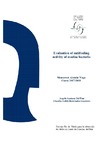Identificador persistente para citar o vincular este elemento:
https://accedacris.ulpgc.es/handle/10553/75000
| Campo DC | Valor | idioma |
|---|---|---|
| dc.contributor.advisor | Santana del Pino, Angelo | - |
| dc.contributor.advisor | Hernández Guerrero, Claudia Judith | - |
| dc.contributor.author | Alemán Vega, Montserrat | - |
| dc.date.accessioned | 2020-10-26T11:51:11Z | - |
| dc.date.available | 2020-10-26T11:51:11Z | - |
| dc.date.issued | 2018 | en_US |
| dc.identifier.other | Gestión académica | - |
| dc.identifier.uri | https://accedacris.ulpgc.es/handle/10553/75000 | - |
| dc.description.abstract | In the marine environment, the substrata (natural or artificial) are rapidly colonized by marine micro and macro-organisms in a process known as biofouling. This phenomenon causes problems and economic losses to marine and shipping industries. Natural compounds from marine bacteria are emerging as potential sources for novel metabolites. The aim of this study was to evaluate the antifouling activity of marine bacteria from sponges and marine sediment of coasts from Baja California Sur, México against eight bacteria involved in the biofilm formation processes. Preliminary inhibition assays against biofilm forming bacteria were performed by cross streak and disk diffusion assay. The most active strains were grown to obtain supernatants by centrifugation. The toxicity and activity of the supernatants in the growth and adhesion inhibition of the bacteria forming biofouling were evaluated. The supernatants were added in matrix paint and evaluate their effectiveness in field experiments. The results showed that the most active strains were Halobacillus trueperi, Bacillus licheniformis (sponge isolates), Vibrio harveyi and Halobacillus sp. (marine sediment isolates) that inhibited the growth and adhesion of the most biofilm forming strains tested. The supernatants were not toxic in none of the tested concentrations. In field experiments, the paint with bacterial supernatants reduced the coverage in the tiles. These bacteria could be used as non-toxic antifouling agents. | en_US |
| dc.language | eng | en_US |
| dc.relation | SIP20170434 (Instituto Politécnico Nacional) | en_US |
| dc.relation | SIP20181803 (Instituto Politécnico Nacional) | en_US |
| dc.subject | 310801 Bacterias | en_US |
| dc.subject.other | Adhesion | en_US |
| dc.subject.other | Antimicrobial | en_US |
| dc.subject.other | Bacillus | en_US |
| dc.subject.other | Bacterial supernatants | en_US |
| dc.subject.other | Halobacillus | en_US |
| dc.subject.other | Paint | en_US |
| dc.subject.other | Sponge | en_US |
| dc.subject.other | Toxicity | en_US |
| dc.subject.other | Vibrio | en_US |
| dc.title | Evaluation of antifouling activity of marine bacteria | en_US |
| dc.type | info:eu-repo/semantics/bachelorThesis | en_US |
| dc.type | BachelorThesis | en_US |
| dc.contributor.departamento | Departamento de Matemáticas | en_US |
| dc.contributor.facultad | Facultad de Ciencias del Mar | en_US |
| dc.investigacion | Ciencias | en_US |
| dc.type2 | Trabajo final de grado | en_US |
| dc.utils.revision | Sí | en_US |
| dc.identifier.matricula | TFT-46437 | - |
| dc.identifier.ulpgc | Sí | en_US |
| dc.contributor.buulpgc | BU-INF | en_US |
| dc.contributor.titulacion | Grado en Ciencias del Mar | - |
| item.grantfulltext | restricted | - |
| item.fulltext | Con texto completo | - |
| crisitem.advisor.dept | Departamento de Matemáticas | - |
| Colección: | Trabajo final de grado | |
Visitas
81
actualizado el 29-jun-2024
Descargas
15
actualizado el 29-jun-2024
Google ScholarTM
Verifica
Comparte
Exporta metadatos
Los elementos en ULPGC accedaCRIS están protegidos por derechos de autor con todos los derechos reservados, a menos que se indique lo contrario.
